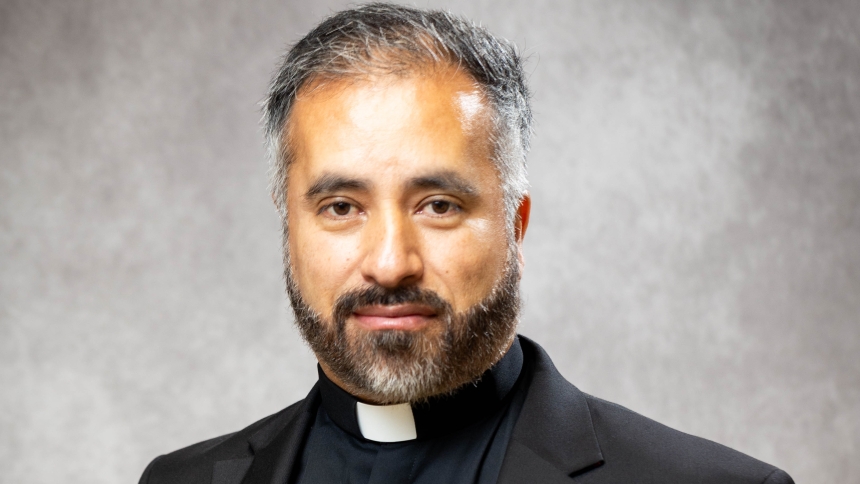SCHERERVILLE - In a casual atmosphere, sharing food and drinks, faithful gathered in St. Patrick Hall at St. Michael the Archangel for Theology Uncorked. The evening events create an informal way for parishioners to learn from and participate in theological discussions.
Janice Gatons, pastoral associate, said she is part of the ministry at the parish that focuses on adult education. For the Theology Uncorked session on Oct. 15, Father Martin Dobrzynski graciously volunteered to lead the evening's presentation.
“He decided that he would give us a tour, basically, of all the garments they wear and the reasons why,” she said. “And everybody thought that was a good idea.”
Father Dobrzynski began by providing some history of Vatican II, also known as the Second Vatican Council. He said the council wanted to renew the liturgy and, in doing so, “many of the old forms, which were not necessarily divinely inspired, needed to be peeled away to get down to what we might call the brass tax.”
“One of the main and important things they put forward at the beginning of that document on the sacred liturgy is some norms,” he said. “The first and overarching arm is that the Church desires earnestly that all the faithful be led to full conscious and active participation in the liturgical celebrations.”
The pastor of St. Michael the Archangel explained the part of sacred furnishings and sacred art, the Church expressed a desire for a noble simplicity of things. What does noble simplicity mean?
“To me, it was pretty obvious when I started studying this in Theology in 1972 that noble simplicity meant just that – it wasn’t ostentatious – that its meaning should be obvious in one degree or another to anyone who is practicing their faith,” Father Dobrzynski said.
Amice
A white linen cloth called the amice, rectangular in size, is the first liturgical vestment a priest puts on to prepare for Mass. Its purpose is to protect both the alb and the vestments. It wraps around the collar as a barrier between the vestment and skin to safeguard against any sweat.
“It’s a reminder that we are putting on Christ,” Father Dobrzynski said. “It’s to hide the identity of the priest in a way. If you know anything about world religions, there is always vesture in world religions, and it's always about hiding and revealing. Christianity is no different. It’s about hiding certain things to reveal certain things. It’s meant to hide the priest or the deacon, because another identity needs to be realized.”
Father Dobrzynski clarified that the purpose of the amice is therefore two-fold, protecting the vestments from sweat and also presenting the person wearing them as somebody different.
The amice, Father Dobrzynski added, originally developed as a hood, a piece of cloth that would go around the neck and then could be lifted over the head.
Alb
“When you are vesting, you should be conscious of what you are doing and what you are preparing yourself for,” Father Dobrzynski said.
He stated the alb is a vestment that came with a meaning from the Church right from the beginning. The white garment is a reminder of one’s own baptism. It’s also the one vestment that can be worn by altar servers.
“It's a reminder of the baptismal dignity of the people ministering,” Father Dobrzynski said.
He shared that the alb is also a sign of purity and Christian dignity.
Cincture
The cincture has a practical purpose, which is to hold the alb in place and aids in making it fit better. It is typically a cord or strip of cloth that helps to “tuck up” the garments to help with movement.
“When Jesus said ‘Gird one's loins and wait for the master,’ what he is saying is ‘Get to work.’” Father Dobrzynski said.
The cincture is also a symbol of purity and continence. Father Dobrzynski noted the cincture is a good reminder for the priest or deacon to ask for God’s help in accomplishing the work he’s being called to do.
Stole
The stole is worn around the neck, hanging over the shoulders of the priest or deacon, and drapes down. It is worn as a sign of authority, reminding the clergy of their dignity in their role within the Church.
“When I put on the stole, I think of the yoke of the office,” Father Dobrzynski said, “not as a burden, but I see it as the invitation to put on the yoke of Christ. I get out of the way as best I can so that Christ shines through.”
Chasuble
In a formal liturgy, the priest will put on a chasuble. Father Dobrzynski noted that the Roman Missal, the book containing the prescribed prayers, chants, and instructions for the celebration of Mass in the Roman Catholic Church, details the importance of no excess ornamentation and simplicity of material used. Most may have a pattern or design woven into it, Father Dobrzynski explained, while other, more special, chasubles may have applied images.
“In Church documents, it talks about that if anything is on the vestments, it should be a symbol or an image that leads you immediately into the sacred,” he said.
The colors of the chasuble have come to represent the time of year in the liturgical season. Green is worn as a sign of hope. The two periods of time the priest will wear green are after the Epiphany or Baptism of the Lord, which closes out the Christmas Season, until the beginning of Lent. The second period for wearing green is after Pentecost to the beginning of Advent.
White is a color for festive celebrations such as Christmas and Easter, or any solemnity liturgies such as a feast day of a saint who is not a martyr. Red is the color worn on feast days of a martyr, Pentecost and confirmations. Purple is traditionally worn during the seasons of Advent and Lent. Rose chasubles are seen on more festive days in a season of penance – Gaudete and Laetare Sundays. Gold is reserved for what Father Dobrzynski deemed high holy days, such as a chasuble he wore for the parish’s 150th anniversary.
In times of solemn vespers, night prayer, benediction, the priest might also put on a cope, a long cloak, and a humeral veil, a rectangular liturgical vestment draped over the shoulders.
“In the Middle Ages, all these vestments came from Roman vestments,” Father Dobrzynski said. “The chasuble was originally like a poncho with sleeves that Romans wore over their clothes. The Church adopted it in about the third century as a vesture for the priest.”
He continued, “They symbolize the function of the ministry and, at the same time, give beauty to the rite we are celebrating.”



